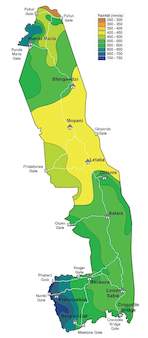
Rainfall

In the local Shangaan traditions these thunderstorms are referred to as 'male' rain, while longer, softer, gentler showers are called 'female' rain.
There is great divergence in Kruger's rainfall - the mean average is approximately 500mm per year, but this varies from an annual average of approximately 760mm in the high rainfall areas of the south, which falls within the 'rain face' of the escarpment, and as low as 210mm in the drier flatlands of the north-east.
There is a longer dry and wet cycle lasting between seven and eleven years, although this could shift as global warming makes weather patterns less predictable. Birding in the same part of Kruger during extreme wet and dry cycles can be a totally different experience.
The rainfall patterns are highly significant from a birding perspective in that the year is clearly divided into wet and dry seasons. Birds breed when food supplies are most assured. The majority of plants - except for those associated with permanent water sources - are deciduous. This means the greatest amount of food is available in summer, which is when most residents breed. The opposite is true for the major raptors whose food supplies are most assured in winter.Studies by AC Kemp have shown that there is a threefold increase in insects during the hot, humid period between spring and the first major summer rains. This usually occurs in October, which sees the start of the breeding cycle of smaller insectivores such as the tits, brubrus, batis's and cameropteras.Once the first rains have fallen there is a veritable explosion in the insect population - according to Kemp, insect numbers increase by 3 000% within a month!
This triggers intense breeding activity of those birds that feed insects to their young. These include non-passerines such as the rollers, kestrels, Secretarybird, swallows, hornbills, kingfishers, bee-eaters, starlings, shrikes, pipits, babblers, drongos, flycatchers, oxpeckers, and passerines such as sparrows and weavers.
The high level of insect nutrition lasts until the end of the rainy season. The wet season also sees many of Kruger's trees bearing fruit, which provides ample nourishment for breeding for fruit-dependent species such as turacos, African Green-Pigeon, Trumpeter Hornbill and barbets.The dry season - from May onwards - provides a niche for more specialised feeders to breed. These include most of the raptors, which breed in the dry season because vegetation cover thins out and therefore it is easier to catch prey.
There is also no competition for food from the summer migrant raptors. Parrots and woodpeckers are also winter breeders because their food sources are seasonally-specific. The staple diet of parrots is dry seed - even though they eat fruit - while woodpeckers prey on insect larvae, which are at their most prolific during the dry season.

